Description
Envisioning Brussels in the 21st Century
While the contribution Brussels as a City of Row Houses: From the Origins to 1914 showed the development of this building type, the article Perpetuating or Opposing the Terraced House in Brussels analysed its further evolution in the 20th century. This text now delineates Brussels’ housing trends after 2000.
Over the past two decades, housing has once again become a matter of urgent debate. Challenges brought about by a series of crises and changes that began in the 20th century have required the development and implementation of new strategies. This is the situation that any innovative housing agenda must face as we transition into the 21st century.[1]
Issues Inherited from the 20th Century
Fragmented government meant 20th-century Brussels lacked coherent urban-planning policies. Planning, even for such sizeable sites as the European Quarter and the Northern Quarter, responded to local development opportunities rather than following any overall structural plan.
While some post-war housing is remarkable, the post-war period nevertheless left a complex legacy at the beginning of the 2000s that must be taken into account.
From an urban point of view, a typological genealogy of overlapping housing types resulted in an extremely fragmented built environment. Indeed, from the 1950s onwards the state strongly encouraged Belgians to leave the city, promoting suburbanisation and the building of so-called pavillionaires – groups of detached houses in suburban settings. The resulting urban sprawl turned the Brussels-Capital Region into a “horizontal metropolis”, a concept defining extended urban spaces characterised by complementarity, loose hierarchies, and territorial synergies.[2] In terms of the built environment, housing in this metropolis extended across administrative boundaries, creating on the one hand the compact city described in this book, and on the other the surrounding Brussels hinterland.
From a social point of view, this suburbanisation generated a massive exodus, so that while the population in the urban agglomeration continued to grow from 1965 onwards, this growth was outside the Brussels region.[3] International immigration, meanwhile, was unable to compensate for internal emigration, bringing about a slow yet persistent population decline. This trend was reversed in the Brussels-Capital Region from 1995 onwards, and the population is expected to increase progressively into the 21st century.[4] Furthermore, new types of households emerged in the 2000s as the result of demographic evolution and migration;[5] these took their place alongside the nuclear family, which had been the central model for post-war initiatives.
From an economic point of view, housing became very expensive for the middle class in the years leading up to 2000, while social-housing production was drastically reduced after the 1970s.[6] In particular, the establishment of the Capital Region’s borders initiated residential relocation away from Brussels, forcing many young families to migrate in order to reduce their cost of living. In terms of affordability, therefore, housing alternatives were required to provide a larger, higher-quality housing offer that also accommodated new social structures. New housing policies needed tools that could establish conditions allowing denser occupancy in quality urban homes. In essence, they were forced to answer the question: how can people live in the city today?
New Administrative, Governance, and Legislative Instruments
Brussels-Capital was acknowledged as a fully-fledged region in 1989, and was immediately compelled to develop a policy addressing new urban challenges linked to housing.[7] Three primary transformations were undertaken in order to define a suitable context for new urban initiatives.
First, the region created the office of Brussels Chief Government Architect (BMA – Bouwmeester/Maitre Architecte) in 2009.[8] The BMA operates independently with a transverse approach on urban planning and architectural policies, and organises competition procedures for public and private projects. Principal tasks are to guarantee a constructive background for interactions among multiple actors; advocate for the quality of the built environment; and test for this quality in proposals concerning architectural design, urban planning, and public space, without regard for economic and political interests.
Second, the administration was reorganised in order to deal with project actors, manage projects in a simplified way, and transcend municipal boundaries. A new platform was created, bringing together three public institutions: Perspective. brussels, proposing solutions and perspectives for territorial planning; the Urban Development Corporation (sau-msi.brussels), carrying out major urban development of strategic significance; and Urban.brussels, granting construction permits and managing historical patrimony.
Third, the regional government focused on regional development in legislative terms. Reform of the Brussels Urban Planning Code (CoBAT) and Environmental Permits (OEP) entered into force in September 2019, simplifying and streamlining urban-planning and environmental-permitting processes.
These changes at governance level demonstrated an evolution in the Brussels-Capital Region’s vision and policy. The result is a system designed to advocate for and enhance spatial quality in urban projects, envision urban transformations at the regional scale, and adopt a series of coherent tools to fulfil these goals.
Demographic Dynamics
Several studies over the last two decades have highlighted the priorities and actions that need to be implemented within Brussels-Capital Region to establish sustainable urban strategies.[9] Their analyses and outcomes are based on demographic growth as predicted from 2000 onwards. Although these predictions have recently been revised,[10] housing remains a crucial issue for urban planning. Indeed, while the demand for housing has increased, affordability of real estate has dramatically reduced, affecting the middle and lower classes.[11] The globalised economy, the city’s internationalisation, changes to the job market, and the city’s role as a cultural catalyst led to two phenomena: the gentrification of some neighbourhoods and the impoverishment of others.
At a metropolitan scale, the role of migratory processes may be summarised in a few key features. First, a significant proportion of inhabitants left poor areas of the city, especially during the years 1960–1980. Second, immigration of a better-off population has been concentrated in the fashionable parts of the city located in the south-east quadrant.[12] Third, the arrival of new middle-class inhabitants into disadvantaged neighbourhoods has produced gentrification, leading to a rise in the cost of housing and spawning new “trendy” areas.[13]
New Housing Initiatives
Contemporary housing projects in Brussels face four main challenges:
1. Addressing demographic changes
Housing projects must consider recent changes in demographic trends, such as reduced family size, an ageing population, and increasing household diversity. This demands a new model, one in which accessibility and affordability are compatible with new household structures and diverse populations.
2. Creating sustainable buildings
Several surveys show the growing importance of energy and material economy in recent Brussels schemes: first, housing projects have been obliged since 2015 to incorporate passive building techniques; second, projects are increasing asked to adopt recycling and reuse, with an eye towards developing suitable living environments.
3. Conceiving new forms of collectivity
Over the last decade, projects across Europe have aimed to develop new forms of collective housing. Brussels is unique in terms of the variety of housing-initiative strategies adopted. New forms of collectivity can foster contact amongst residents.
4. Experimenting with space
The city may be considered a laboratory for testing different types of spatialisation and challenging accepted paradigms. This applies to a variety of projects and housing typologies.
Brussels Initiatives Responding to Contemporary Housing Questions
Recent housing projects have transformed the city of Brussels according to various strategies that respond in diverse ways to the four main axes highlighted above. Contemporary housing initiatives in Brussels can be categorised according to eight themes. The order in which the strategies are presented ranges from those most closely resembling the dominant type to those with more innovative and experimental forms.
Re-inventing the maison bruxelloise: Variations on a House
The maison bruxelloise currently constitutes approximately one third of Brussels’ housing stock.[14] The flexible arrangement and dimension of domestic spaces as well as the compact circulation characterising this dominant type allow small-scale projects such as splitting existing homes or merging terraced houses to create apartments. Indeed, a maison bruxelloise will in many cases have lost its individual character. The buildings are too spacious for smaller contemporary Brussels households and their evolving lifestyles. The renovation of these terraced houses to suit new norms and needs nevertheless offers an opportunity to test their relevance within the framework of contemporary challenges. In particular, the traditional three-room-in-a-row layout was banned under the 1979 Building Regulations of the Agglomeration, which require all living spaces to have a direct opening to the outdoors.[15] Even though these projects are based on the conditions specific to each case, we can nevertheless highlight several tendencies revealing a wide range of design complexity.
One of the most recurrent mutations is the inversion of the traditional spatial hierarchy, which occurs both horizontally or vertically. First, the garden, considered a leftover space in the 19th century, has gained interest, modify- ing the hierarchy of the house by placing the most important living spaces towards the back. New spatial configurations designed to create more intimate domesticity and adaptable spaces for new daily uses therefore occur on the ground floor, as exemplified by House William (2017, Ouest architecture) and the terraced house Charme 9 (2016, Atelier 4/5).
Second, the verticality dominating daily life inside these typical buildings has been revalued. While the space under the roof was originally considered a technical space reserved for servants, nowadays it is transformed into living space. A great number of projects add new storeys, offering more living surface as well as novel perspectives, both looking away from the house towards the city and towards the house from the street. A case in point is the apartment building Népomucène 15 (2015, KIS Studio).
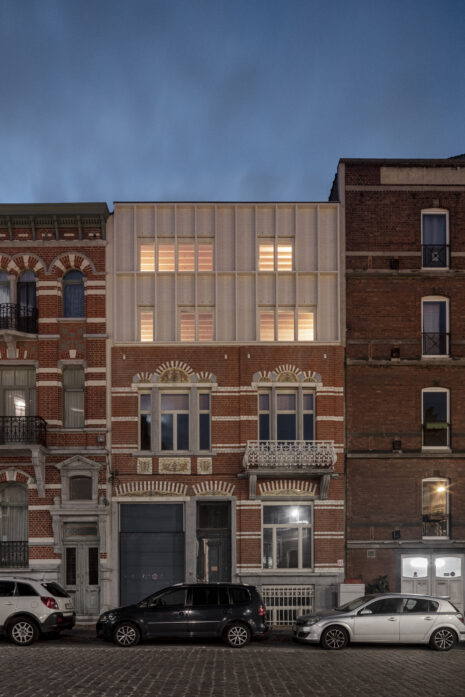 Example of vertical inversion of the traditional spatial hierarchy. While the space under the roof was originally reserved for servants, nowadays many projects transform and enlarge the volume for living space (Hé! Architectuur, rooftop extension Karper, 2021).
Example of vertical inversion of the traditional spatial hierarchy. While the space under the roof was originally reserved for servants, nowadays many projects transform and enlarge the volume for living space (Hé! Architectuur, rooftop extension Karper, 2021).
Innovative re-inventions are also driven by social changes. Large families living in a maison bruxelloise have progressively disappeared, but new forms of co-living requiring specific characteristics in terms of spatial flexibility – i.e. housing an elderly family member (maison kangourou) – have appeared, for instance the terraced “kangaroo” house at Dumont 5 (2018, VVV architecture urbanisme).
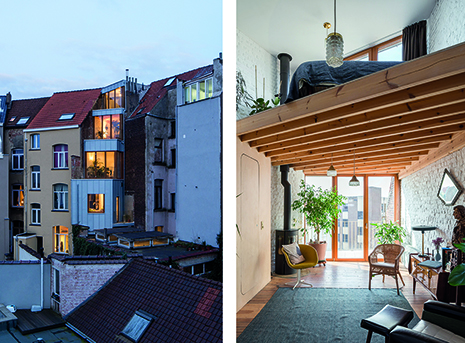 The renovated house at Dumont 5 (2018, VVV architecture urbanisme) has a“kangaroo”concept, i.e. the cohabitation of two households with elderly and younger inhabitants around a common space.
The renovated house at Dumont 5 (2018, VVV architecture urbanisme) has a“kangaroo”concept, i.e. the cohabitation of two households with elderly and younger inhabitants around a common space.
Projects in this category share some common features. The first is increasing spatial adaptability/polyvalence to meet contemporary domestic needs and ways of living. Indeed, the original rooms’ flexibility lends itself to potential evolution. Second, staircases and vertical circulation are emphasised as an architectural element representing new domestic structures. Third, the garden and terraces connected to the living spaces play a significant role in the layout. Fourth, the original facade on the street side is preserved, while a new facade is designed on the garden side.
Reviving Urban Blocks: The Fabric Condition
In some Brussels neighbourhoods, the historic urban fabric faced neglect and became degraded in the post-war period because of anti-urban modernist initiatives and the departure of middle-class residents.
Since the beginning of the 1990s, Brussels-Capital Region policies have favoured initiatives in these underprivileged territories of the city. So-called “Neighbourhood Contracts” became one of the most powerful among these urban-policy tools for improving resident households’ living conditions, reinforcing the attractiveness of the living environment, and curbing social inequality.[16] In particular, they establish a framework for a series of complementary projects at the neighbourhood scale: new constructions and renovation of housing, renewal of public spaces, new public infrastructures and facilities, initiatives to foster social cohesiveness.[17] These public policies aim to encourage and increase the social mix in these neighbourhoods.[18] Indeed, working-class households have a demographic profile similar to that of the middle classes: households with young children.[19]
In this context, contemporary initiatives to revive urban blocks are made up of small-scale projects characterised by their direct confrontation with the typical built environment of the maison bruxelloise. Three categories have been identified according to their morphological features.
In the first category are housing projects dealing with the typical urban block structure. While single-family terraced houses are increasingly uncommon in Brussels (a rare recent example is the terrace house at Claes 36, 2014, AgwA), new collective housing consisting of apartments is designed to adapt to the typical size of pre-existing plots and negotiate the fragmented skyline of the street fronts.
In addition to typological inventions to accommodate apartments in limited dimensions, these projects often include collective gardens shared by residents – such as at the apartment building Fin 15 (2011, ectv architecten Els Claessens Tania Vandenbussche) – or a garden open to the neighbourhood as can be found at the apartment building Mexico 15 (2020, VERS.A).
Due to their atypical setting, corner plots can be considered unusual elements of Brussels urban blocks since they usually have little access to the block interior. This second category has thus developed innovative typological solutions opening only towards public space. Corner buildings can combine a set of spatial features similar to the maison bruxelloise with public facilities (for instance the apartment building Palais 95, 2012, Matador) and adopt a qualitative overlapping of diverse apartment types for social housing, such as large one-floor apartments and duplexes. Two examples for this approach are the apartment buildings Portaels 158 (2016, MSA, V+) and Navez 111 (2015, LOW architecten). These corner projects tend to be designed as sculptural volumes highlighted by abstract variations on traditional decorated street fronts such as bright colour or motif textures. Furthermore, corner buildings address cohesion between typology, sculptural shapes, and pre-existing houses in order to create an appealing design.
Despite their successful architectural results, recent temporary housing projects nevertheless encourage a city built for consumption as opposed to housing designed for permanent residents.
The third category consists of projects addressing the morphological issues characteristic of already fragmented urban blocks. In this context, large double-aspect apartments are combined with modernist features in layout and facade, for instance at Apartment Building Helihavenlaan 7 (Eugen Liebaut, 2005); other projects use the block interior to densify the neighbourhood. They integrate pre-existing buildings such as Savonnerie Heymans (MDW Architecture, 2011) or new public facilities (e.g. at the apartment building Cygnes Digue, Ledroit Pierret Polet Architectes + Atelier de l’Arbre d’Or + Label Architecture, 2014) into the fabric of a single urban block. In this case, the resulting complexity is used to differentiate apartment types within the block. This complexity becomes more relevant when housing projects accommodate specific uses, for instance collective spaces.
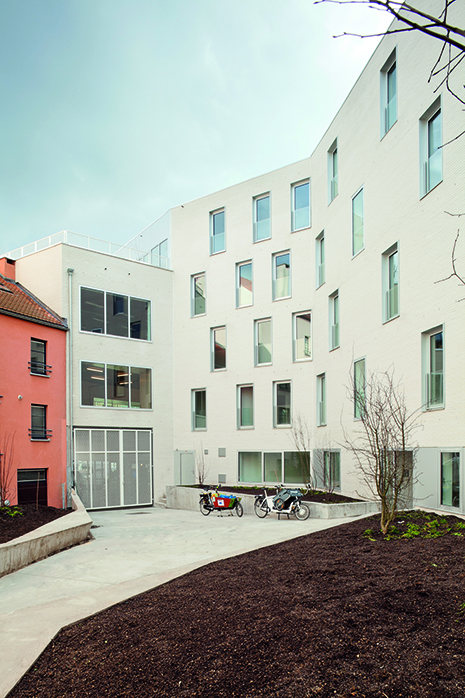 The apartment building Cygnes Digue, Ledroit Pierret Polet Architectes + Atelier de l’Arbre d’Or + Label Architecture, 2014, included a garden inside the block that can be used also by neighbours.
The apartment building Cygnes Digue, Ledroit Pierret Polet Architectes + Atelier de l’Arbre d’Or + Label Architecture, 2014, included a garden inside the block that can be used also by neighbours.
In general terms, initiatives to revive urban blocks develop as polyvalent tools for creating new pieces of city. For economic reasons, most of these projects are designed as apartment buildings, rarely as single-family houses; they nonetheless share several characteristics with the standard housing type. Typological overlapping is thus adopted in order to deal with the existing variety of the built environment. Alongside the dominant maison bruxelloise (i.e. the terraced house), these interventions reinvent the traditional mix of the Brussels block to house a great variety of functions. Furthermore, morphological features characterising urban blocks (such as building height, block alignments, and building-coverage ratio) are taken into account as part of the design. New interpretations can also be seen on the facades: on the one hand new materials and textures emerge from the variety of the street front, on the other they stress the difference between the public, street-side facade and the domestic one on the block side.
Re-using Types: No City for Old Housing
Projects from the post-war period constitute critical elements in the city in terms of neighbourhood location, surface area, and urban density. Today, post-war buildings are outdated, abandoned, and often negatively perceived by inhabitants as icons of the demolitions undertaken as part of “Bruxellisation”. To deal with these buildings, two rehabilitation trends have emerged.
Rehabilitation of Post-War Housing Slabs
Housing slabs built after the Second World War face three crises. First, social changes transformed the nuclear family structure around which these projects were designed. Second, due to their construction, these slabs are energy-consuming and provide inadequate thermal performance. Third, the materials used in the facades are now outdated. Post-war housing must accommodate new household structures, environmental requirements, and technologies. At the same time, contemporary projects meet these requirements by transforming the spatial configuration of apartments. While post-war units were designed according to the modernist precepts of the “minimum dwelling” and normative standards, today they need to provide appropriate spatial conditions for contemporary ways of living. Three design approaches have emerged in response to this need.
First, more and more projects transform the modernist facades of post-war slabs. Prefabricated concrete facades and steel-framed windows need to be updated to meet contemporary low-energy standards. In these cases, the facade is entirely wrapped with thermal insulation and then covered again with a new layer of prefabricated elements in order to preserve and reinterpret the decorative qualities of the original facade.
In the second approach, a new, independent structure is positioned in front the original facades as a “second skin”, providing each apartment with additional surface area, for example in the form of loggias or winter gardens as at the Apartment Building Peterbos 9 (51N4E, Lacaton & Vassal, 2024).
While this approach works by simple addition to the pre-existing building, the third approach generates typological mutations. Attaching a new structure to the façade to provide more surface can enlarge the size of bedrooms, today considered too small by unit residents; a good example is the apartment building Tilleuls (Karbon, approx. 2024). Domestic configuration is consequently transformed, producing novel unit types such as duplex apartments and more typological variety than allowed by the original repetition of standardised units.
For all three approaches, the rehabilitation of post-war housing slabs usually consists of interventions such as the renovation of façades, technical equipment, stairwells, and common spaces in order to improve energy performance while the new designs consider the spatial configuration as well. In particular, both closed or open galleries along façades provide additional domestic space that residents can use according to their lifestyles. New unit configurations foster a typological diversity accommodating a variety of households, which was not provided for by the standardised post-war design.
Conversion of Non-Residential Buildings into Housing
Before the First World War, Brussels was the most important industrial city in Belgium, with large industrial sites and warehouses, especially along the Brussels Canal. After the Second World War, Brussels’ economy was increasingly outsourced, resulting in a sharp increase in non-residential spaces, in particular office buildings.[20] Today, the city has a large amount of unoccupied commercial and office space, and the trend is the conversion of these buildings into housing.[21]
Several decades of deindustrialisation produced a large reserve of abandoned warehouses and small office buildings, especially in districts like the centre, Molenbeek, and Anderlecht, where the housing market was under pressure. Many non-residential buildings were converted through private-sector and residents’ initiatives. The spaces’ generous volumes and surfaces accommodate lofts of diverse configuration, combining living and working spaces. These new typologies often revolve around a collective environment in the form of a common garden courtyard, for instance at the co-housing apartment building P.NT².
The trend of converting office buildings is also used to foster housing and urban quality in business districts. By preserving the original concrete structure, these projects offer freely adaptable plans. Due to their width and preservation of the original circulation spaces, they can be turned mostly into single-aspect small units such as studios and one-bedroom flats – and, less frequently, into large apartments based on modular dimensions. For good-quality housing, exterior open spaces must be provided, often through the addition of balconies along the facades as at The Cosmopolitan. The pre-existing vertical orientation makes efficient use of the building footprint and promotes the compactness envisioned for the city, by encouraging mixed use and space flexibility.
The re-use of unoccupied and abandoned office buildings forces housing design to deal with pre-existing volumes. It reduces the amount of energy and construction waste generated by demolition and new building. Calculations have demonstrated that preventing massive demolitions means lower construction costs and CO2 emissions. Furthermore, the pre-existing structure of non-residential buildings allows free unit plans and typological variations. The adoption of mixed uses results in a hybridisation that reverses post-war monofunctional zoning.[22]
Modern Urban Villas: The Importance of Being Free-Standing
Many Belgians aspire to live in detached houses in the suburbs or countryside. Green open spaces and nature around the city are especially valued by families with children, who often flee the city in search of more affordable homes. The green areas in Brussels’ 20th-century belt constitute an opportunity for new free-standing projects. Alongside such large, dense housing sites as interwar garden cities, the low-rise urban villa is one of the most significant models adopted for contemporary use. First, there are individual urban villas in private ownership such as Maison Krantz-Fontaine.
The second, relatively recent type is collective urban villas. Since such projects are usually located in green areas, their building-coverage ratio is minimised. They experiment with new spatial connections between typology and nature: while apartments with a winter garden or terraces allowing different interior configurations can produce unexpected perspectives on the landscape, such as at Vervloet, collective spaces combined with the natural environment can create a continuous polyvalent zone for residents.
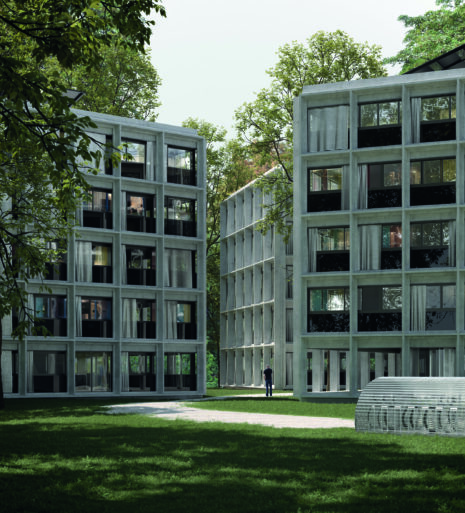 The 37 dwellings in the three free-standing, five-storey buildings of Vervloet – Villa Nord (Matador, BAUKUNST, 2023) in Uccle are mostly equipped with wintergardens.
The 37 dwellings in the three free-standing, five-storey buildings of Vervloet – Villa Nord (Matador, BAUKUNST, 2023) in Uccle are mostly equipped with wintergardens.
Recent urban-villa projects therefore respond to the Belgian aspiration to live near nature with innovation in urban-housing typology. They strive to increase connections with surrounding greenery on two levels. First, a compact, free-standing volume only occupies a low percentage of the green area. Second, the ground floor often features an organic configuration (for an individual urban villa), while it accommodates spaces for community life in a collective urban villa.
New Forms of Communal Housing: Close Encounters with the Neighbours
Two key facts have driven grassroots initiatives in Brussels. First, property prices have doubled over the last decade, and real-estate market inventory has failed to keep up with population growth, diversity of demand, and average incomes. The affordable housing crisis is particularly acute in dense working-class neighbourhoods along the canal.[23] Second, demographic changes such as reduced family size and the diversity of households require a built environment able to accommodate a diverse population.
These grassroots projects evolved in the last two decades into various forms of communal housing projects. At the beginning of the 2000s, “bourses d’achat collectives” brought together groups of non-professional buyers looking for small or medium-sized dwellings with a view to the collective acquisition of large vacant buildings. The purchase and basic renovation work were organised collectively by these groups. More recently, innovative forms of co-housing – habitats groupés – have emerged, though their numbers remain limited.[24] The term “co-housing” refers to housing forms characterised by the sharing of certain living spaces and a participatory dimension. The non-speculative nature of co-housing projects allows residents to be involved through self-management, promotes pooling of resources and collaboration, and accommodates both mixed-use and mixed-income configurations.[25] Furthermore, co-housing aims to achieve social cohesion and inclusion, caring for an aging population, organising the community, and providing gender- and child-friendly environments.
Four types of co-housing can be distinguished. The first is the bourses d’achat collectif, which initially involved the conversion of pre-existing industrial sites. These buildings were usually transformed with a casco (i.e. structure, windows, and heating only but no finishing) configuration, which means that loft units were designed according to the available space and then each private apartment was customised by its residents. While these pre-existing constructions can vary from a corner block – as exemplified by the apartment building CôtéKanal (Metamorfose Project Team, Marcel Rijdams, 1998) – to large industrial buildings (for instance, the conversion of a former printing house from the 1930s, Nimifi, Atelier Gigogne, Ravenstein III, 1999, or the refurbishment of the former wire-drawing mill La Tréfilerie by AAAArchitectures, 2007), they all include collective spaces such as courtyards and gardens; private open spaces such as balconies, loggias, verandas, and terraces are added to the original structure. New housing volumes can also be combined with the pre-existing building, in particular to accommodate atypical dwellings such as duplex types, artists residences, etc., an approach used at the apartment building Cheval Noir (L’Escaut, Atelier Gigogne, 2010).
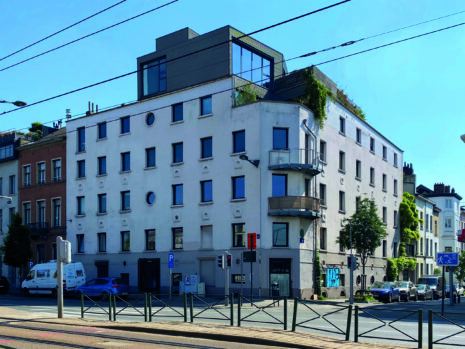
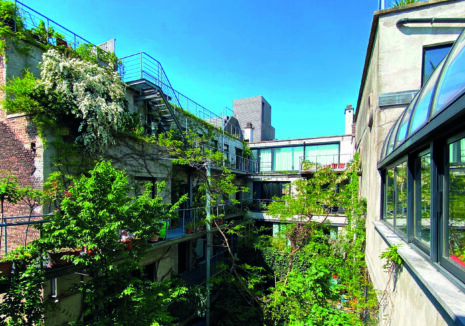 CôtéKanal, realised in 1998 in the buildings of a former brewery (Metamorfose Project Team, Marcel Rijdams), is one of the oldest co-housing projects in Brussels.
CôtéKanal, realised in 1998 in the buildings of a former brewery (Metamorfose Project Team, Marcel Rijdams), is one of the oldest co-housing projects in Brussels.
The second is private initiatives; these also aim at affordable co-housing. Co-housing can result in empowerment, for instance by enabling disadvantaged families to privately own duplex apartments through participatory practices as it was the case at L’Espoir (Carnoy-Crayon, 2007). In addition to a typological combination of dwellings, spaces for community life – like common gardens, shared spaces, and collective amenities – are often incorporated, usually on the ground floor as at Brutopia(Stekke + Fraas, 2015).
While these projects are mainly “self-managed” cluster housing units initiated by the residents themselves, the two remaining types are chiefly promoted and regulated by public authorities.
In the concept of Community Land Trust (CLT), which is behind the third type, “affordable” is not limited to the development of housing for low-income residents, but also extends to the opportunity to buy a home without buying the land. This concept has been experimented with by the private initiatives of co-housing (that realised Habitat groupé Tivoli, Epoc, 2021) and by the creation of the Community Land Trust Brussels (CLTB) to offer low-income Brussels residents affordable and sustainable quality homes. By involving residents in the design and management, these projects aim to generate a sense of community within the project.
The fourth, a new co-housing and communal living trend, embodies the idea of community through housing design. In this case, co-housing is to foster social cohesion through a balance of unit types and collective spaces. For instance, housing projects for the elderly or the disabled consist of minimum-sized dwellings enriched by large circulation areas to encourage social interaction, such as a large gallery (used at the co-housing apartment building Engelenbergstraat 21, Dierendonckblancke, 2024) or a corridor provided by common spaces (Villa Pilifs, Pierre Blondel Architectes, 2015) alongside gardens and equipment. One of the most recent trends is represented by CLTB projects mixing unit types for both an intergenerational and an intercultural purpose with a focus on gender, while providing housing for low-income families.
Despite their great variety, new forms of co-housing nevertheless share several features. First, co-housing projects display a wide degree of design versatility, from self-managed converted buildings and new constructions to initiatives by public and social institutions. Therefore, the goal behind the architecture – to create a collective and community environment – is sometimes more important than the typologies themselves.
Second, they involve an inclusive and participative approach allowing both architects and residents to take part in pivotal decisions.[26] On the one hand, the general design scheme and collective spaces are discussed and decided jointly by residents. On the other hand, each household works with a specific architect on their domestic space. As a result, this process reinforces, in a dynamic way, residents’ collaborative involvement in project design.
Third, units are designed to suit the specific domestic needs of their users. Projects consist of a combination of unit types, which reinterprets the typological and social diversity characterising a traditional Brussels block.
Fourth, collective amenities, circulation, and open spaces are not considered merely complementary to dwellings, but valued as indispensable to the collective intentions of the project design.
Fifth, multi-purpose spaces and public facilities prompt neighbourhood dynamics. Their small scale contributes actively to the local economy and promotes social interaction, creating a sustainable environment for further urban developments.
Large-Scale Projects: Canal Landscape with a Tower
In addition to small-scale dynamics, the Brussels-Capital Region had political ambitions to work on large-scale projects across municipal borders. To this end, the government prioritised the formerly industrial Canal Area and also launched several new strategic development sites[27] requiring a global and transversal strategy. In 2013, a new urban master plan for the 14-km-long stretch of canal structuring the city from south to north[28] was implemented. At the core of this development is a mix of urban functions and economic strengthening, with a potential 25,000 housing units to meet domestic demand. This framework envisions large-scale housing projects to reactivate brownfield sites. Due to their former industrial use, the available large plots operate as catalysts for transforming the Canal Area, often in conflict with the current, lower-income population.
In recent years, the results have been reflected in the dynamics promoted by private developers and investors in particular. Two complementary and sometimes interwoven trends can be seen along the Brussels Canal.
First, proposals were made to clear the residual industrial fabric and densify the city through open urban blocks.[29] This urban layout would allow for a group of apartment buildings designed to create urban conditions ex nihilo.
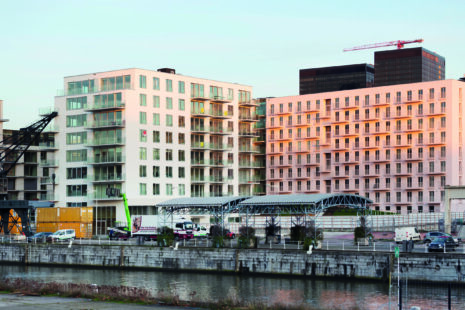 The nine-storey apartment building at Akenkaai 36, BEEL architecten, 2019, belongs to the recently built open urban blocks along the Brussels Canal.
The nine-storey apartment building at Akenkaai 36, BEEL architecten, 2019, belongs to the recently built open urban blocks along the Brussels Canal.
Each building is designed by a different architectural firm, thus stressing its architectural autonomy. On the one hand, an open urban block can consist of apartment buildings perpendicular (Akenkaai 36, BEEL architecten, 2019) and parallel (Willebroekkaai 22, 51N4E, 2019) to the canal sharing a common garden; on the other, project layouts generate a fragmented urban environment unified only by proximity on a shared plot (Mansion Block, Sergison Bates architects, 2025). All privately built developments combine standard apartments with limited typological variations with generous open spaces such as balconies, loggias, and terraces.
By contrast, in projects by public clients, the open urban block incorporates neighbourhood facilities (Rempart des Moines – Southern Block, MDW Architecture, LAN).
A second trend in these large-scale initiatives is projects changing the urban skyline. Recent schemes by private developers use tower-type housing as a tool to build the 21st century metropolis.
The Canal is already the site of the highest residential skyscraper in Belgium (Up-Site Tower, A2RC, Ateliers Lion, 2014), and a series of high-rise buildings are expected to establish a new urban landscape. These projects propose mixed-use configurations adopting a standard set of spatial and distribution features (Havenlaan 12, OFFICE Kersten Geers David Van Severen – Nicolas Firket Architects), occasionally introduce collective amenities for the residents (for instance, at the apartment building Dockside, MSA, TRANS, V+, 2024) and in a number of cases reinterpret elements of the Art Deco towers built in the 1930s in their vertical development and circulation spaces (Dayton, noArchitecten, 2022).
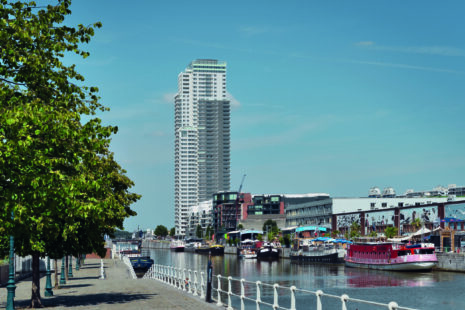 The Up-Site Tower on the Brussels Canal (A2RC, Ateliers Lion, 2014) is Belgium’s highest residential skyscraper and comprises 251 dwellings.
The Up-Site Tower on the Brussels Canal (A2RC, Ateliers Lion, 2014) is Belgium’s highest residential skyscraper and comprises 251 dwellings.
Common aspects emerge from a comparison of these trends. First, the large dimensions of brownfield sites lend themselves to large-scale developments over the division of the space into smaller plots.[30] Second, the open-block model increases urban porosity by including green surfaces, but this does not match the existing fabric of Brussels. The resulting free layouts could be executed in any city. The city envisioned by these projects is a “global” metropolis, appealing to an international audience. Third, the unit plans are usually guided by pragmatic concerns, in particular in the private sector. Compared with the referential housing type, characterised by a standard ratio and flexible spaces, these projects propose conventional schemes with standard sizes and few innovations. Fourth, outdoor spaces are fundamental elements in the spatial configuration of each dwelling. In the end, despite the need for affordable homes, also for larger families, developers have systematically chosen to build chiefly small one- and two-bedroom apartments – a typology that delivers to investors the highest profit per square metre – aimed at the upper middle classes and foreigners.[31]
Living and Producing: Workers Leaving the Factory
Brussels, historically the largest industrialised city in Belgium, experienced a process of de-industrialisation in the post-war period.[32] This produced empty urban areas and disused industrial sites. One of the Brussels-Capital Region’s goals is to retain and expand light industry.[33] Contemporary projects connecting workplace and housing engage with sustainable issues such as urban mobility, housing affordability, and social cohesion. To meet these goals, a brand-new trend has emerged in Brussels for projects combining, in a liveable way, productive activities with housing. New typological configurations are needed to deal with these mixed uses. The southern sector of the Canal Area, which is currently not very accessible, has been identified as an area for urban development.
Two design approaches can be identified. First, mixed-use projects propose a new urban block consisting of a podium occupying the entire plot and a vertical development with specific purposes at each level: the podium accommodates productive activities; shared gardens and collective open space (Making a/+ Living — Northern Tower, plusoffice architects, MSA, B2Ai, 2025) or a car park are located on the roof of the podium; and apartments of diverse typologies are located in towers.
Projects of the second type do not have a large podium but create a new urban district with a focus on the redevelopment of industrial sites, now open to and continuous with the city. This transformation offers a lower-density and mixed-use combination of affordable homes, light industrial and commercial facilities, and neighbourhood public services.
Both design approaches share the goal of building “a city in a city” in which the proximity principle – with the combination of living and working, production and consumption – defines a sustainable concept of a compact city for Brussels.[34] These projects stand for a kind of design hybridisation that accommodates the different scales demanded by light industry and housing. Thus, both high-rise and low-rise housing include flexible spaces for mixed use and apartments enhanced by collective spaces.
Housing Manifestos: Prototypes as Inspiration
During the 2010s, several incisive studies and non-built design proposals alerted architects, clients, and the government to urgent urban-housing issues. These projects can be considered manifestos offering a sustainable vision of the city.
For instance, in the post-war period large portions of the city – such as the European quarter, where most of the European institutions are located – were completely transformed into monofunctional office clusters. A gradual transformation of office buildings was proposed to combine affordable housing and work space in a hybrid urban block as part of the same productive stream.[35] The proposal also drew attention to the typological evolution of Brussels housing, as the site was occupied by a typical Leopold-era urban block before these post-war transformations.
Recent years have brought forth new visions that attempt to intercept the transitions occurring in contemporary housing, which is to accommodate all seasons of life – youth, adulthood, old age – rather than normalise family living. The CLTB experiments with new layouts and adaptable construction to translate into living spaces the evolving nature of family living over the years and decades[36] (exemplified by the housing prototype Do you see me when we pass?, Dogma). The attitude appears to be a continuation of the utopian projects such as Le Nouveau Bruxelles by Victor Bourgeois (1930) and Ville lineaire by Renaat Braem (1934).
Several grassroots initiatives spreading in Brussels in response to the lack of affordable housing are also manifestos in their own right. The temporary occupation of pre-existing spaces in transition, such as squats, has become a recognised practice and more recently a strategy legalised by the authorities.
People – such as the homeless, undocumented families, activists, refugees, precarious workers, artists, students – who enter an abandoned building without authorisation can sign a temporary occupation agreement with the owner. This allows them to remain for an indefinite period, with six months’ notice, providing stability for the development of self-management and solidarity housing. This form of housing raises questions about the temporary occupation of sites or buildings as a tool for increasing the density of the city and offers a model of social organisation prefiguring a new, sustainable life cycle for urban spaces.
These manifesto projects as well as squatting models form prototypes defining the conceptual framework and operational tools for their development. They propose forms of collective living that critically inspire housing production in the Brussels-Capital Region.
Contemporary Housing Agencies
Over the last two decades, housing development has experienced a shift in Brussels thanks to a renewed momentum and vision by its regional authorities, as well as local initiatives such as the contrats de quartier, bourses d’achats collectifs, temporary occupations, self-managed initiatives etc. While they were limited to the Brussels-Capital Region, they also had some impact on the city’s hinterland, i.e. the two Brabant provinces, forming a metropolitan area of more than 2 million inhabitants, twice the population of the city itself.
From 2000 on, urban housing in Brussels has been engaged in a transition process to make city living sustainable for and attractive to its inhabitants in the 21st-century city. The result is a dense city designed to provide a variety of dwelling types corresponding to an increasingly diverse population. In addition, this typological variety is complemented by new forms of management and alternative forms of tenure – such as housing cooperatives and the Community Land Trust Brussels (CLTB) – which offer effective solutions to current economic and social challenges.
There is nevertheless a need to expand contemporary housing initiatives as current housing policies are insufficient to meet demand. A growing proportion of households do not have the necessary financial resources for housing, and the market in Brussels does not address the growing inequalities of access to housing.[37] In fact, many families with children and disadvantaged people prefer to leave Brussels in order to escape the high prices. Furthermore, 47 % of current Brussels households consist of a single person and 23 % of two people.[38] This demographic trend encourages standardised concepts for domestic spaces following the rules of the market.
At the end of this chapter, once again the question emerges: how can people live in the city today?
Affordable housing and diversified dwelling types are crucial to create the conditions for a liveable city. The contemporary housing dynamics highlight the wealth of built solutions in terms of design. Nevertheless, there is still a need for innovation and experiments in architectural design, typology, public investments, stakeholder collaborations, and land-use regulation. New housing projects will need to meet ongoing and future issues, such as climate change, co-living, gender equality, migrations, and working-living combinations – all emphasised by the 2020/2021 COVID-19 outbreak. The contemporary city is built continuously on a palimpsest, the stratifications of earlier built fabric and new visions. Like the dominant maison bruxelloise and the other forms of housing that have emerged up to the 21st century, contemporary housing must add to these past layers to strengthen and continue the urban and socio-cultural identity of the Brussels-Capital Region.
Footnotes
Porotto, Alessandro and Gérald Ledent. “Crisis and Transition: Forms of Collective Housing in Brussels.” Buildings, vol. 11, no. 4, 162, 2021, pp. 1–31.
The concept of “horizontal metropolis” as defined by Studio Bernardo Secchi and Paola Viganò emerged in the study Brussels 2040. Dejemeppe, Pierre and Benoit Périlleux. Bruxelles 2040. Brussels, Region de Bruxelles-Capitale, 2012.
Deboosere, Patrick et al. “The Population of Brussels: A Demographic Overview.” Brussels Studies, no. 3, 2009, pp. 1–16; Dehaibe, Xavier et al. “Projections démographiques communales bruxelloises 2015–2025.” Les Cahiers de l’IBSA, Institut Bruxellois de Statistique et d’Analyse (IBSA), 2016.
Berns, Hannah et al. “Towards a paradigm shift in the residential appeal policy of the Brussels-Capital Region.” Brussels Studies, no. 172, 2022, pp. 1–31; Dehaibe, Xavier et al. “Projections démographiques communales bruxelloises 2015–2025.” Les Cahiers de l’IBSA, Institut Bruxellois de Statistique et d’Analyse (IBSA), 2016.
Casier, Charlotte. “The transformation of demographic structures and the geography of Europeans in Brussels between 2000 and 2018.” Brussels Studies, no. 138, 2019, pp. 1–16; Deboosere, Patrick et al. “The Population of Brussels: A Demographic Overview.” Ibid. no. 3, 2009.
Dessouroux, Christian et al. “Housing in Brussels: Diagnosis and Challenges.” Brussels Studies, no. 99, 2016, pp. 1–31.
Demographic growth, multiculturalism and social changes, mobility and urban developments, as well as a lack of public services. The existence of multiple other administrative structures in addition to the Region (including the federal government, 19 municipalities, and 2 linguistic communities with related institutions) made the situation more complex. De Visscher, Lisa. “Brussels, Urban Governance for a Metropolis.” A+, no. 278, 2019, pp. 106–112
This new position follows the examples of the Bouwmeester in Flanders and the Stadsbouwmeester in Antwerp.
Dejemeppe, Pierre and Périlleux, Benoit. Bruxelles 2040. Bruxelles, Region de Bruxelles-Capitale, 2012; T’Jonck, Pieter. “Quelle métropole en 2040?” A+, no. 235, 2012, pp. 44–50.
Growth seems to have plateaued in 2020 due to the COVID-19 outbreak. Hermia, Jean-Pierre. “Baromètre démographique 2021 de la Région de Bruxelles-Capitale.” Focus, Institut Bruxellois de Statistique et d’Analyse (IBSA), 2021, pp. 1–8.
De Laet, Sarah. “The Working Classes are also Leaving Brussels. An Analysis of the Suburbanisation of Low-Income Populations.” Brussels Studies, no. 121, 2018, pp. 1–24.
For instance, the most popular neighbourhoods are Ixelles, Saint-Gilles, Etterbeek, Woluwe-Saint-Pierre, and Woluwe-Saint-Lambert.
Van Criekingen, Mathieu. “What is Happening to Brussels’ Inner-city Neighbourhoods? : Selective Migration from Areas Undergoing Gentrification.” Brussels Studies, no. 1, 2006, pp. 1–21.
Ledent, Gérald. “Potentiels Relationnels: L’aptitude des dispositifs physiques de l’habitat à soutenir la sociabilité: Bruxelles, le cas des immeubles élevés et isolés de logement.” PhD Dissertation, Université catholique de Louvain, 2014.
Eloy, Marc et al. Influence de la législation sur les façades bruxelloises. Brussels, C.A.R.A./C.F.C., 1985.
Ananian, Priscilla. “Housing Production in Brussels: The Neighbourhood City to Stand the Test of Urban Densification.” Brussels Studies, no. 107, 2016, pp. 1–18; Lenel, Emmanuelle. “Social Mix in Public Urban Action in Brussels: Project or Political Language?” Brussels Studies, no. 65, 2013, pp. 1–12.
Berger, Mathieu. Le temps d’une politique: Chroniques des Contrats de quartier bruxellois. Brussels, CIVA, 2019; Cohen, Maurizio. À Bruxelles, près de chez nous: L’architecture dans les contrats de quartier. Brussels, Ministère de la Région Bruxelles-Capitale, 2007.
Ananian, Priscilla. “Housing Production in Brussels: The Neighbourhood City to Stand the Test of Urban Densification.” Brussels Studies, no. 107, 2016, pp. 1–18; De Laet, Sarah. “The Working Classes are Also Leaving Brussels: An Analysis of the Suburbanisation of Low-income Populations.” Brussels Studies, no. 121, 2018, pp. 1–24; Van Criekingen, Mathieu. “What is Happening to Brussels’ Inner-city Neighbourhoods?: Selective Migration from Areas Undergoing Gentrification.” Brussels Studies, no. 1, 2006, pp. 1–21; Van Hamme, Gilles et al. “Migratory Movements and Dynamics of Neighbourhoods in Brussels.” Brussels Studies, no. 97, 2013, pp. 1–13.
De Laet, Sarah. “The Working Classes are Also Leaving Brussels: An Analysis of the Suburbanisation of Low-income Populations.” Brussels Studies, no. 121, 2018, pp. 1–24.
Dessouroux, Christian. “Les bureaux à Bruxelles: un état des lieux.” Bruxelles: Ses bureaux: Ses employés, edited by Michel De Beule and Christian Dessouroux, Brussels, Rossel, 2009, pp. 14–25.
Borret, Kristiaan. “Should I Stay or Should I Go?” A+, no. 270, 2018, pp. 60–63; Dessouroux, Christian. “Fifty Years of Office Building Production in Brussels: A Geographical Analysis.” Brussels Studies, no. 35, 2010, pp. 1–14.
Lasserre, Christian. “Des bureaux pour toujours? Reconversions au long cours.” Bruxelles: Ses bureaux: Ses employés, edited by Michel De Beule and Christian Dessouroux, Brussels, Rossel, 2009, pp. 111–119.
Lenel, Emmanuelle et al. “Contemporary Co-housing Experiments in the Brussels-Capital Region.” Brussels Studies, no. 142, 2020,
pp. 1–19.
Ibid.
Tummers, Lidewij. “Understanding Co-housing from a Planning Perspective: Why and How?” Urban Research & Practice, vol. 8, no. 1, 2015, pp. 64–78.
Ledent, Gérald and Salembier, Chloé. “Co-Housing to Ease and Share Household Chores? Spatial Visibility and Collective Deliberation as Levers for Gender Equality.” Buildings, vol. 11, no. 5, 189, 2021, pp. 1–23.
Heysel, Reyers, Southern Quarter, West Station site, Josaphat, Delta Herrmann-Debroux, Usquare in Ixelles, the prison sites in Saint-Gilles and Forest, European Quarter, Bordet, the campuses Erasme, Plaine, Laerbeek, and Alma of the main Brussels universities, Boulevard Leopold III, and the NATO site.
Région de Bruxelles-Capitale and Alexandre Chemetoff. Plan-Canal/Kanaalplan. Gentilly, Les éditions du bureau des paysages, 2014.
The “open block” concept was defined and adopted for architectural design by Christian de Portzamparc in the 1980s. Accorsi, Florence. L’îlot ouvert/The Open Block: Christian Portzamparc. Brussels, AAM, 2010).
Le Fort, Barbara and Jean-Philippe De Visscher. “Typo-morphological Diversity and Urban Resilience: A Comparative Study of Three Heterogeneous Blocks in Brussels.” Urban Morphology, vol. 24, no. 1, 2020, pp. 70–94.
Mabilde, Julie. “Brussels, Compact City.” A+, no. 278, 2019, pp. 28–34.
De Boeck, Sarah and Michael Ryckewaert. “The Preservation of Productive Activities in Brussels: The Interplay between Zoning and Industrial Gentrification.” Urban Planning, vol. 5, no. 3, 2020, pp. 351–363.
Borret, Kristiaan. “Brussels Productive City.” Perspective – Bureau bruxellois de la planification, 2019.
Mabilde, Julie. “Brussels, Compact City.” A+, no. 278, 2019, pp. 28–34.
Dogma. Living and Working. Cambridge, Mass., MIT Press, 2022, p. 68.
Tattara, Martino. “Alternative Models of Tenure: Recovering the Radical Proposal of Collective Housing.” Architecture and Collective Life, edited by Penny Lewis, Lorens Holm, and Sandra Costa Santos, New York, Routledge, 2021, pp. 55–67.
Dessouroux, Christian et al. “Housing in Brussels: Diagnosis and Challenges.” Brussels Studies, no. 99, 2016, pp. 1–31.
Data provided by IBSA & Statbel (RN) about the size of Brussels households in 2022.
Internal Links
Originally published in: Gérald Ledent, Alessandro Porotto, Brussels Housing. Atlas of Residential Building Types, Birkhäuser, 2023. Edited for Building Types Online.